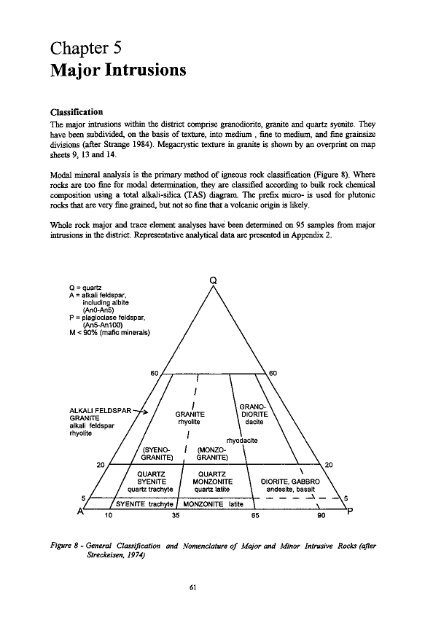- Page 2 and 3:
UNIVERSITY OF HONG KONGLIBRARIES
- Page 4 and 5:
© Government of Hong KongPublished
- Page 7 and 8:
CONTENTSTitle pagePage1ForewordCont
- Page 9 and 10:
Distribution and Lithology 73Detail
- Page 11 and 12: Chapter 10 Economic Geology 149Intr
- Page 13 and 14: (Plates)Plate 22 - Porphyritic Medi
- Page 15: Table 1 — Grain Size Description
- Page 18 and 19: 0 1 2 3 4 5 k mCONTOURS AT 100m INT
- Page 20 and 21: properties of the marine deposits b
- Page 22 and 23: Archival DataAll records from the s
- Page 24 and 25: Chapter 2Outline of GeologyThe soli
- Page 26 and 27: The Mesozoic volcanic rocks are div
- Page 29 and 30: Chapter 3Palaeozoic Sedimentary Roc
- Page 31 and 32: Carboniferous metasedimentaiy rocks
- Page 33 and 34: Plate 1 - Fining-Upward Sequence of
- Page 35 and 36: Plate 3 - Well-bedded Sandstones an
- Page 37 and 38: Reef Island. The northern end of th
- Page 39 and 40: Table 3. Evolution of Nomenclature
- Page 41 and 42: are crudely stratified and welded i
- Page 43 and 44: Shing Mun FormationThe type localit
- Page 45 and 46: Tai Che Tung. Crystal tuff, interpr
- Page 47 and 48: Plate 7 • Lapilli-Ash Crystal Tuf
- Page 49 and 50: Plate 11 - Pyroclastic Breccia (086
- Page 51 and 52: appears fragmental, and contains mu
- Page 53 and 54: exposures in the stream bed consist
- Page 55 and 56: Lin Fa Shan. The steep eastern flan
- Page 57 and 58: dipping northwest at 46°, is prese
- Page 59 and 60: Sunset Peak MemberThe Sunset Peak M
- Page 61: Plate 16- Block and Lapilli-bearing
- Page 65 and 66: in grain size from 0.4 to 1.5 mm, a
- Page 67 and 68: 20 - Megacrystic Medium-grained Gra
- Page 69 and 70: Pui O Wan. Porphyritic medium-grain
- Page 71 and 72: minimum age of c. 145 Ma (see earli
- Page 73 and 74: The granite on Chek Lap Kok is most
- Page 75 and 76: Southeast of Tin Sam, on the wester
- Page 77 and 78: About 1 km east of Nam Shan, exposu
- Page 79 and 80: Plate 25 - Thin Section of Porphyri
- Page 81 and 82: Chapter 6Minor IntrusionsIntroducti
- Page 83 and 84: The microgranite grades southwards
- Page 85 and 86: the Lantau Formation, however, and
- Page 87 and 88: Plate 29 - Flow-banded Quartzphyric
- Page 89 and 90: also cut volcanic rocks of the Tsue
- Page 91 and 92: Silver Mine Bay. On the headland so
- Page 93 and 94: Plate 33 - Core stone Development i
- Page 95: Plate 37 - Thin Section ofLamprophy
- Page 98 and 99: Pre-Yensfaanlan StructureWithin the
- Page 100 and 101: separates areas of different lithol
- Page 102 and 103: NeotectonicsFault activity in the r
- Page 105 and 106: Chapter 8Metamorphism and Alteratio
- Page 107 and 108: the majority of rocks in the distri
- Page 109: Chapter 9Superficial GeologyIntrodu
- Page 112 and 113:
Detailstal O. Alluvial deposits for
- Page 114 and 115:
trains. The regolith on most steep
- Page 116 and 117:
Plate 44 - Boulder Debris on the So
- Page 118 and 119:
gazetted for recreational purposes.
- Page 120 and 121:
DetailsTai O. Extensive intertidal
- Page 122 and 123:
Plate 48 - Sandy Beach at Fan Lau S
- Page 124 and 125:
Pre-Chek Lap Kok Formation Deposits
- Page 126 and 127:
formation. The sequence is usually
- Page 128 and 129:
BOREHOLE NO: ESC 17GRID REFERENCE:
- Page 130 and 131:
BOREHOLE NO: A5/1GRID REFERENCE: 80
- Page 132 and 133:
formation, thinly laminated clays o
- Page 134 and 135:
Quinqueloculina seminulum, which is
- Page 136 and 137:
Channel and Transgressive Deposits.
- Page 138 and 139:
Figure 20 - Areas of Acoustic Turbi
- Page 140 and 141:
West Lamma Channel These may be att
- Page 142 and 143:
Figure 23 - Depth-Averaged, Maximum
- Page 144 and 145:
The formation is Holocene in age. T
- Page 146 and 147:
Boreholes (A5/1, A5/2, B2/1, ESC17
- Page 148 and 149:
Plate 51 - Deep Weathering Profile
- Page 151 and 152:
Chapter 10Economic GeologyIntroduct
- Page 153 and 154:
Non-metalliferous MineralsFissure v
- Page 155 and 156:
REFERENCESAddison, R. (1986). Geolo
- Page 157 and 158:
James, J.W.C. (1993). The offshore
- Page 159 and 160:
Sewell, R.J., Strange, PJ., Langfor
- Page 161 and 162:
Appendix 1Microfossils identified f
- Page 163 and 164:
Appendix 2 (continued)Sample HK9913
- Page 165 and 166:
Appendix 2 (continued)Sample HK1054
- Page 167 and 168:
Appendix 4aSelective normalized pal
- Page 169 and 170:
,Appendix 5 -Radiocarbon and Other
- Page 171 and 172:
construction materials 151contact m
- Page 173 and 174:
molybdenite 149Mong Tung Hang 151Mo
- Page 175 and 176:
talus 107,115Tarn Tsui Wan 71,87Tan
- Page 177:
LB 555.125 G34 LGeology of Lantaii

















